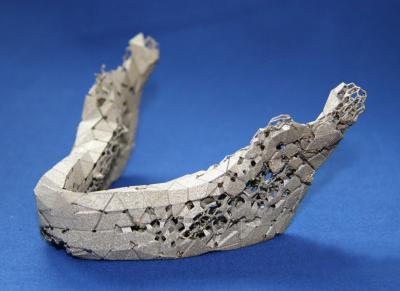Scientists have long been fascinated by structure of bone. Bone is very light but can withstand heavy pressure and he inside is like a sponge so bone is firm and compact in certain places and porous in others.
The construction industry would love to have materials like bone. Researchers at the Fraunhofer Institute for Manufacturing Engineering and Applied Materials Research have developed a simulation program that calculates the internal structure and density distribution of bone material and, from that, the scientists were able to derive the material structure for other components. The program simulates how the structure needs to be built in order to meet the specified requirements.

The researchers have now managed to put these simulations successfully into practice and engineers can produce complex components with the aid of rapid prototyping technology.
This involves coating a surface with wafer-thin layers of special metal powder. A laser beam heats, or sinters, the powdered metal in the exact places that need to be firm.
"It's like baking a cake," says Andreas Burblies, spokesman for the Fraunhofer Numerical Simulation of Products, Processes Alliance. Any remaining loose powder is subsequently removed. "The end product is an open-pored element," explains Burblies. "Each point possesses exactly the right density and thus also a certain stability."
The method allows the engineers to produce particularly lightweight components, customized for each application, that are also extremely robust. In the meantime, the researchers have further enhanced the process to the point where they can actually change the internal structure of the parts after production by means of precision drilling.
"We can manufacture and adapt the parts exactly as required," says Burblies. This makes the technique very attractive to a number of industries, among them the manufacturers of bone implants.
It is easy to produce individual implants with an internal structure that resembles the patient's bone. Metal powders made of biomaterials such as titanium and steel alloys make it possible to reconstruct other bone elements, such as parts of the knee.
And it goes without saying that the lightweight construction industry, especially aircraft, automobile and machine manufacturers, all benefit from the robust workpieces, as they are better able to withstand stress of every kind.





Comments